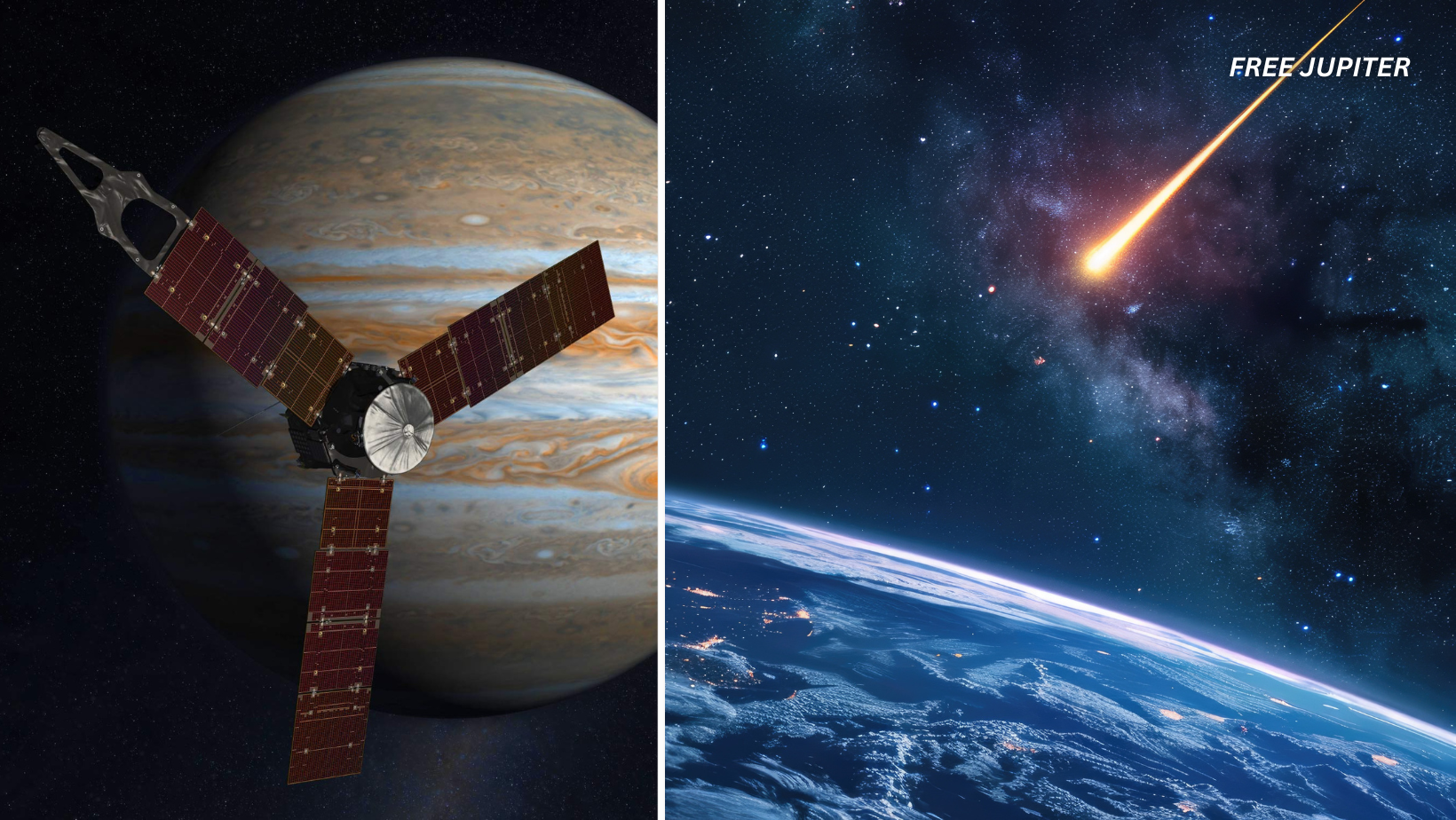Friendly Note: FreeJupiter.com shares general info for curious minds 🌟 Please fact-check all claims—and always check health matters with a professional 💙
The universe occasionally delivers surprise guests, and in July 2025, astronomers confirmed a rare and remarkable one—3I/ATLAS. This icy wanderer isn’t just another comet; it’s the third known interstellar object (ISO) to pass through our Solar System. Like a tourist stopping briefly before heading to another destination, it will swoop in, curve past the Sun, and continue on its way, never to return.
And here’s the twist: NASA’s Juno spacecraft, which has been orbiting Jupiter since 2016, might be in just the right place—and at just the right time—to intercept it. With a clever change in trajectory, Juno could pull off an interstellar flyby, something no spacecraft has ever done before.
This possibility isn’t just exciting for space scientists; it could redefine how we think about missions to unexpected cosmic visitors.
A Short History of Interstellar Visitors
Until recently, interstellar objects were the stuff of theory. Astronomers assumed they must exist—chunks of rock or ice ejected from other planetary systems—but no one had ever seen one up close. That changed in 2017, when the Pan-STARRS observatory in Hawaii spotted a strange, elongated object zipping through at high speed.
Nicknamed ‘Oumuamua (“scout” in Hawaiian), it was unlike any asteroid or comet seen before. It didn’t have a visible tail, it was oddly shaped, and it seemed to accelerate in a way sunlight alone couldn’t explain. This mystery prompted lively debates, with some—including Harvard astronomer Abraham Loeb—speculating whether it might be a piece of alien technology.
Then, in 2019, the comet 2I/Borisov was discovered by an amateur astronomer in Crimea. Unlike ‘Oumuamua, Borisov looked like a typical comet, complete with a glowing coma and tail, but its speed and path confirmed it came from outside the Solar System.
These two finds proved that interstellar visitors are real and detectable—though extremely rare. Scientists began dreaming up missions to chase future ones, but such plans faced a major challenge: these objects arrive without warning and move incredibly fast, making intercepts difficult.
Read more: Scientists Find Evidence Pointing to a Compact Object Hidden Inside the Sun
Enter 3I/ATLAS
On July 1, 2025, the Asteroid Terrestrial-impact Last Alert System (ATLAS) telescope in Rio Hurtado, Chile, spotted a faint, fast-moving point of light. Further observations confirmed it was on a hyperbolic path—meaning it wasn’t bound to our Sun.
Officially named 3I/ATLAS (C/2025 N1), it is only the third interstellar object ever detected. Early brightness measurements suggested it might be unusually large, possibly around 20 kilometers across, if it reflects light poorly like most dark asteroids. Later Hubble images hinted it might be much smaller—under 3 kilometers in radius—but either way, it’s big enough to study in detail.
Why This Flyby Is a Rare Opportunity
Normally, intercepting an interstellar comet would mean designing, building, and launching a spacecraft in record time—something that’s logistically and financially near-impossible. But 3I/ATLAS has a lucky quirk: it will pass relatively close to Jupiter in March 2026.
Juno, already in orbit around Jupiter, could—if given the green light—alter its path to meet the comet during this flyby. This means no new rocket launches, no years-long wait, and no guesswork about whether the spacecraft could catch up.
According to calculations by Loeb and his colleagues Adam Hibberd and Adam Crowl, a small but well-timed thrust in September 2025 could steer Juno into 3I/ATLAS’s path. They propose using a Jupiter Oberth Maneuver, a clever gravity-assisted boost where the spacecraft fires its engines at the point in its orbit when it’s moving fastest near the planet. This way, every bit of fuel produces the maximum possible change in speed.
What Makes Interstellar Objects So Fascinating
Studying asteroids and comets from our own Solar System has already taught us a lot about how planets form. These icy and rocky leftovers preserve a record of the early Solar System’s chemistry, temperatures, and even potential ingredients for life.
But interstellar objects are a different level of treasure. They formed around another star, in a completely different environment, and have been drifting for millions—or even billions—of years before arriving here. Their composition could reveal:
- What kinds of materials are common in other planetary systems
- Whether certain building blocks of life are universal
- How planets and stars elsewhere eject debris into interstellar space
And in the very unlikely case that an ISO turned out to be artificial—something Loeb has speculated about—such a discovery would change science (and perhaps society) forever.
The Instruments Juno Would Bring to the Encounter
If redirected, Juno wouldn’t just be a camera on a comet-chasing joyride—it’s a fully equipped science lab. Its toolkit includes:
- JunoCam – A visible-light camera for detailed images
- Ultraviolet Spectrograph – To detect gases and study the comet’s atmosphere (coma)
- Microwave Radiometer – To peer below the surface and measure temperatures
- Infrared Spectrometer – To map surface composition and detect ice
- Magnetometer – To study the object’s magnetic field (if any)
- Plasma and Particle Detectors – To analyze the solar wind’s interaction with the comet
- Gravity Science Instruments – To estimate the comet’s mass and density
Together, these instruments could produce a full physical and chemical profile of 3I/ATLAS—something never done before for an interstellar object.
Why a Dedicated Mission Isn’t an Option
As exciting as 3I/ATLAS’s arrival is, missions take time. Even the fastest spacecraft ever built—the Parker Solar Probe—took years to develop. A new mission designed and launched in 2025 simply wouldn’t reach the comet before it’s gone.
That’s why the idea of using an existing spacecraft is so appealing. Hibberd and Crowl ran trajectory simulations using custom software that factored in Jupiter’s gravity, Juno’s current orbit, and the comet’s projected path. The math showed it could work—but only with precise timing and enough leftover propellant.
Loeb’s team stresses this is a once-in-a-generation alignment. Most interstellar objects never come near a giant planet, let alone one with a functioning spacecraft already in orbit.
A Hypothesis Worth Testing—Even If It’s Unlikely
While Loeb gained attention for suggesting ‘Oumuamua might be alien tech, he doesn’t insist that’s the case for 3I/ATLAS. Still, he argues that the possibility—even if remote—shouldn’t be ignored. The scientific method, after all, demands we test hypotheses, however far-fetched, especially when the cost of checking is low compared to what’s at stake.
“If such an object turned out to be artificial, it could have significant consequences for humanity,” Loeb notes. “It’s worth investigating thoroughly.”
But even if 3I/ATLAS is an ordinary comet, the encounter would still give scientists unprecedented insights into the building blocks of other star systems.
What Happens Next
As of now, the decision rests with NASA mission planners. Redirecting Juno would extend its mission beyond the original end date of September 2025. The trade-off is that Juno would forgo its planned plunge into Jupiter’s atmosphere—an event designed to prevent any risk of contaminating Jupiter’s moons with Earth microbes.
If NASA approves the plan, the key maneuver would take place in early September 2025, with the flyby of 3I/ATLAS occurring in mid-March 2026. Data would then be transmitted back to Earth over the following months, potentially revealing a detailed portrait of an object from another star system.
If the plan isn’t approved, astronomers will still observe the comet from Earth and space-based telescopes as it approaches the Sun and heads back into the void. Its path will bring it unusually close to Mars, Venus, and Jupiter—an orbital coincidence scientists find curious.
Why This Matters Beyond Astronomy
This opportunity isn’t just about space science—it’s about how we respond to rare and fleeting chances. In many ways, it’s a test of whether our space agencies can pivot quickly when nature presents an unplanned but scientifically rich event.
It also underlines a broader truth: the universe doesn’t run on our schedules. These cosmic visitors appear unexpectedly, stay briefly, and vanish forever. The question is whether we’ll be ready the next time—and whether “next time” will come in years or centuries.
Read more: MRI Scans Show Your Dog Loves You More Than Other Dogs Or Even Their Favorite Snacks
A Possible First Step Toward the Stars
If Juno does meet 3I/ATLAS, it would mark the first close-up study of an interstellar comet. The knowledge gained could guide the design of future “interstellar interceptors,” spacecraft kept on standby to launch at short notice when the next ISO is detected.
Until then, 3I/ATLAS is racing toward the inner Solar System. Its closest approach to the Sun will be in October 2025, after which it will speed away, eventually disappearing into the black between the stars. Whether we watch it go from afar or chase it down with Juno, it’s a reminder that our Solar System is not an island—it’s part of a vast, interconnected galaxy where travelers occasionally pass through, carrying secrets from distant worlds.










